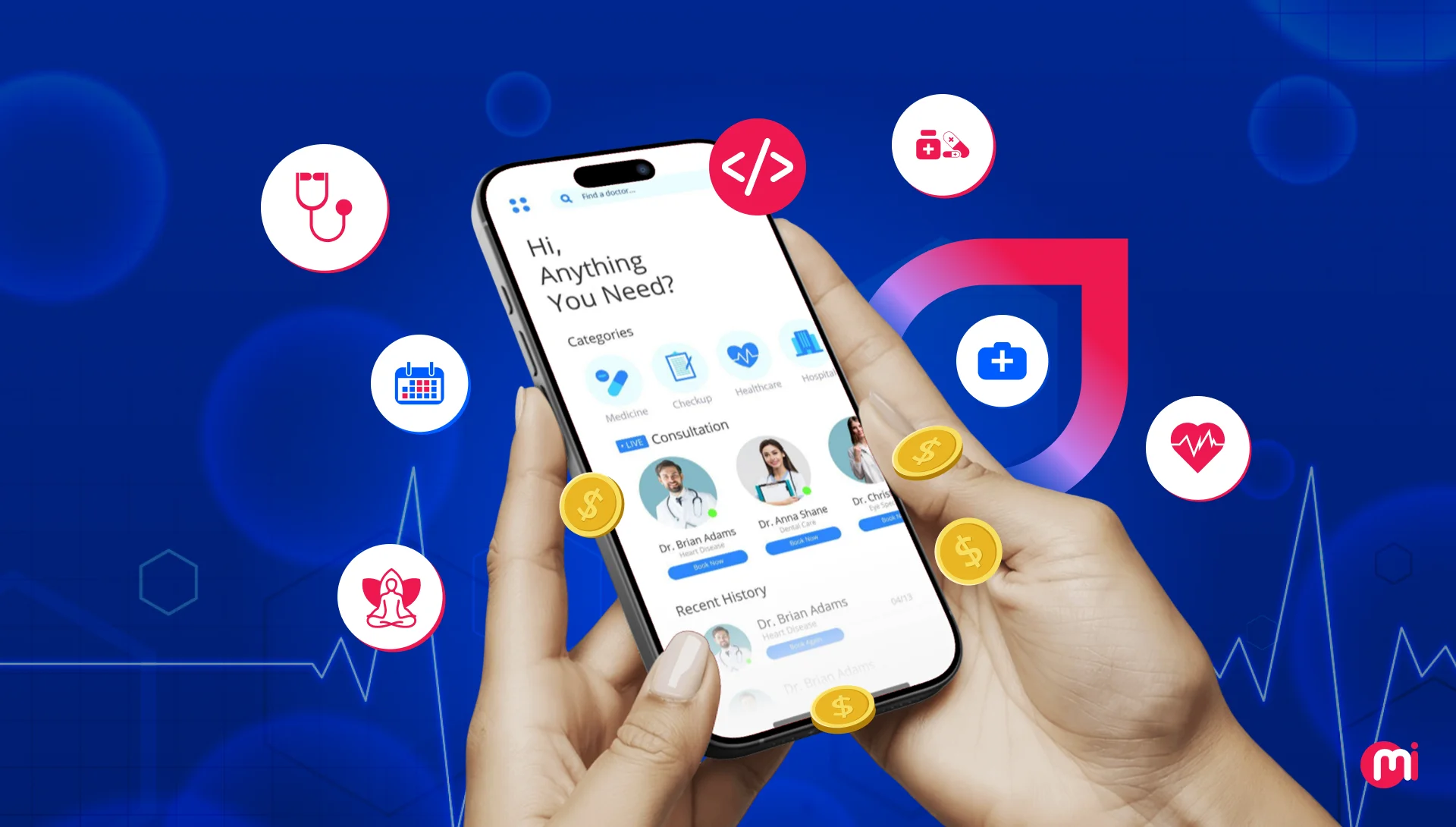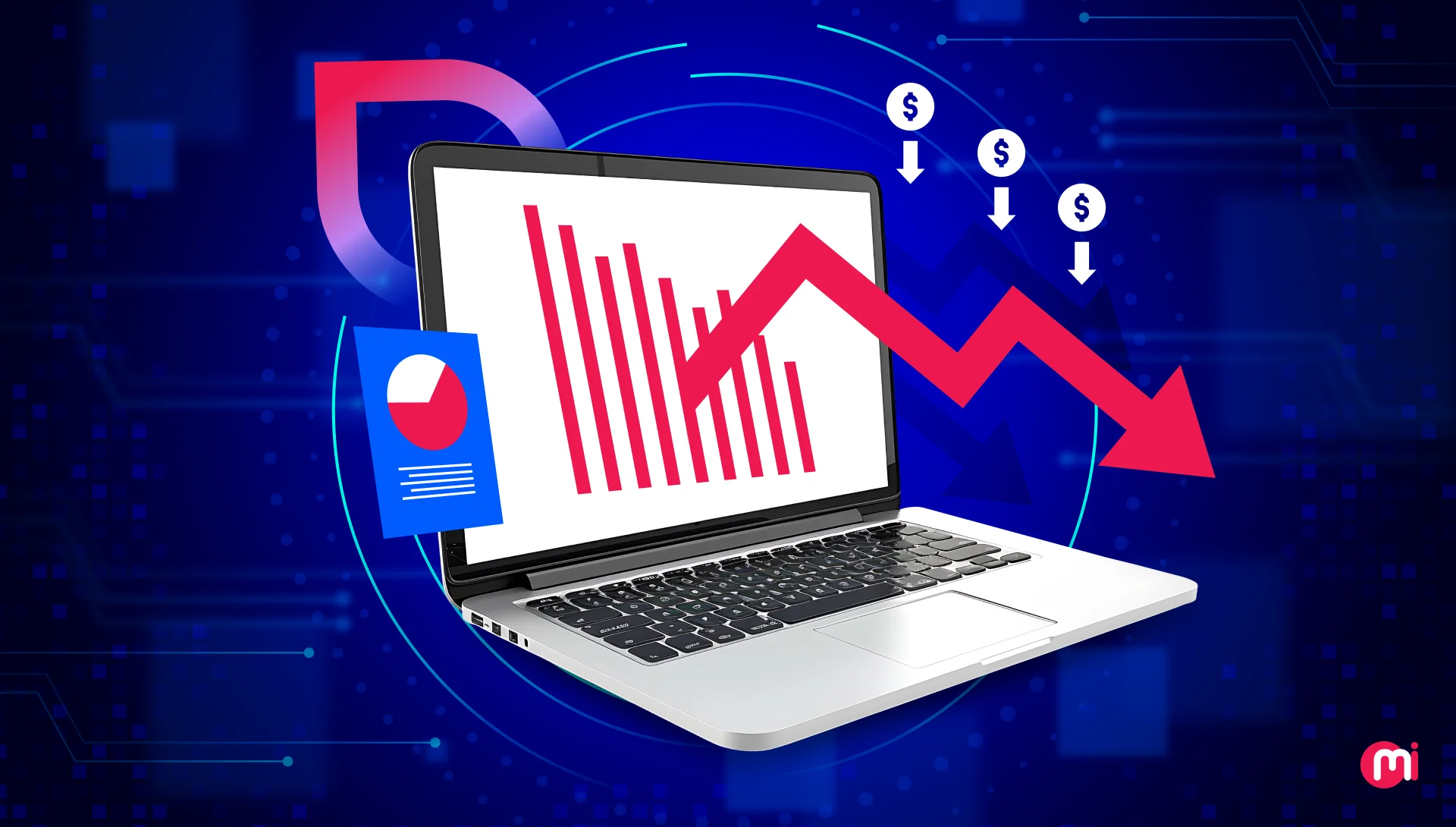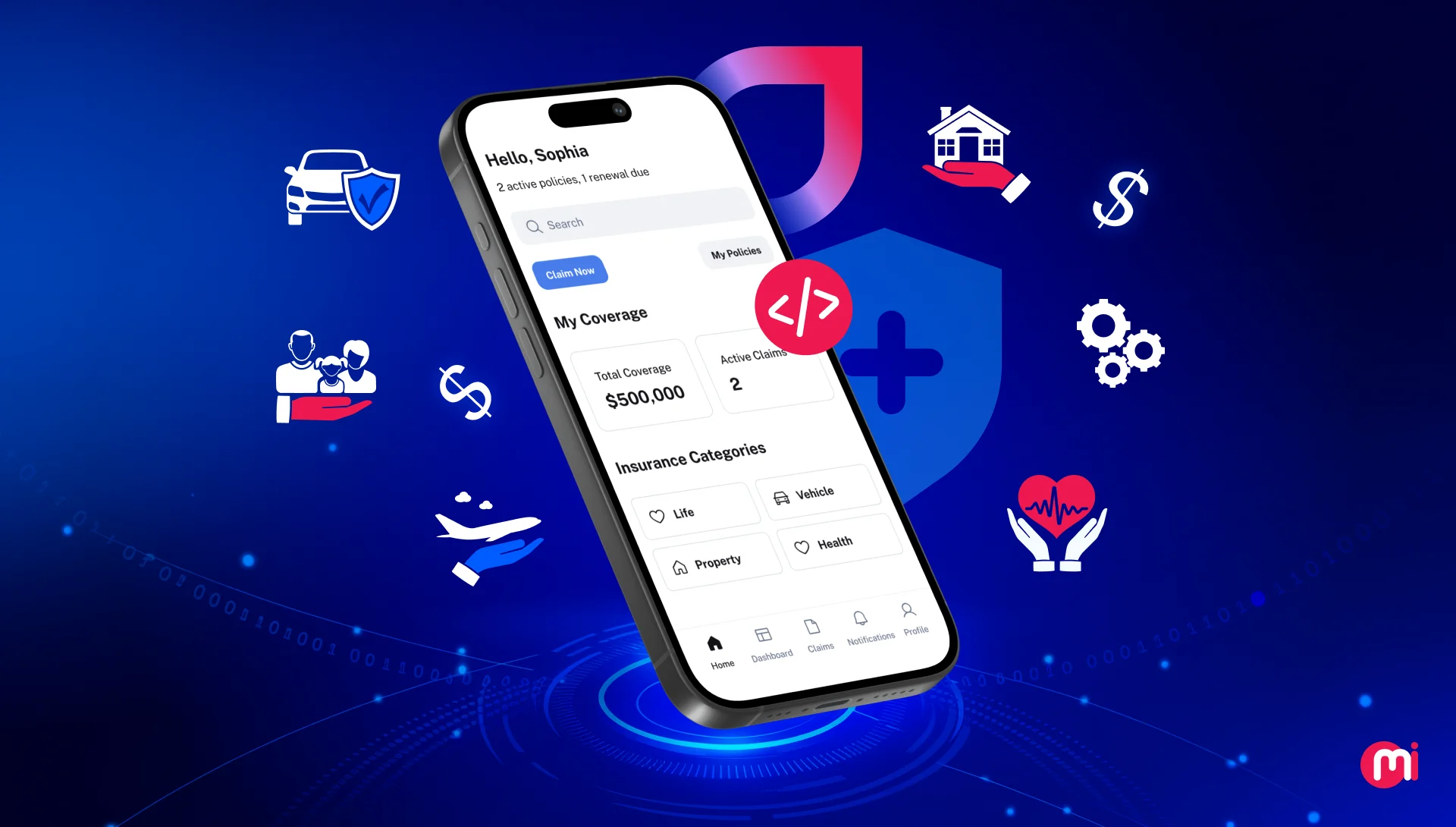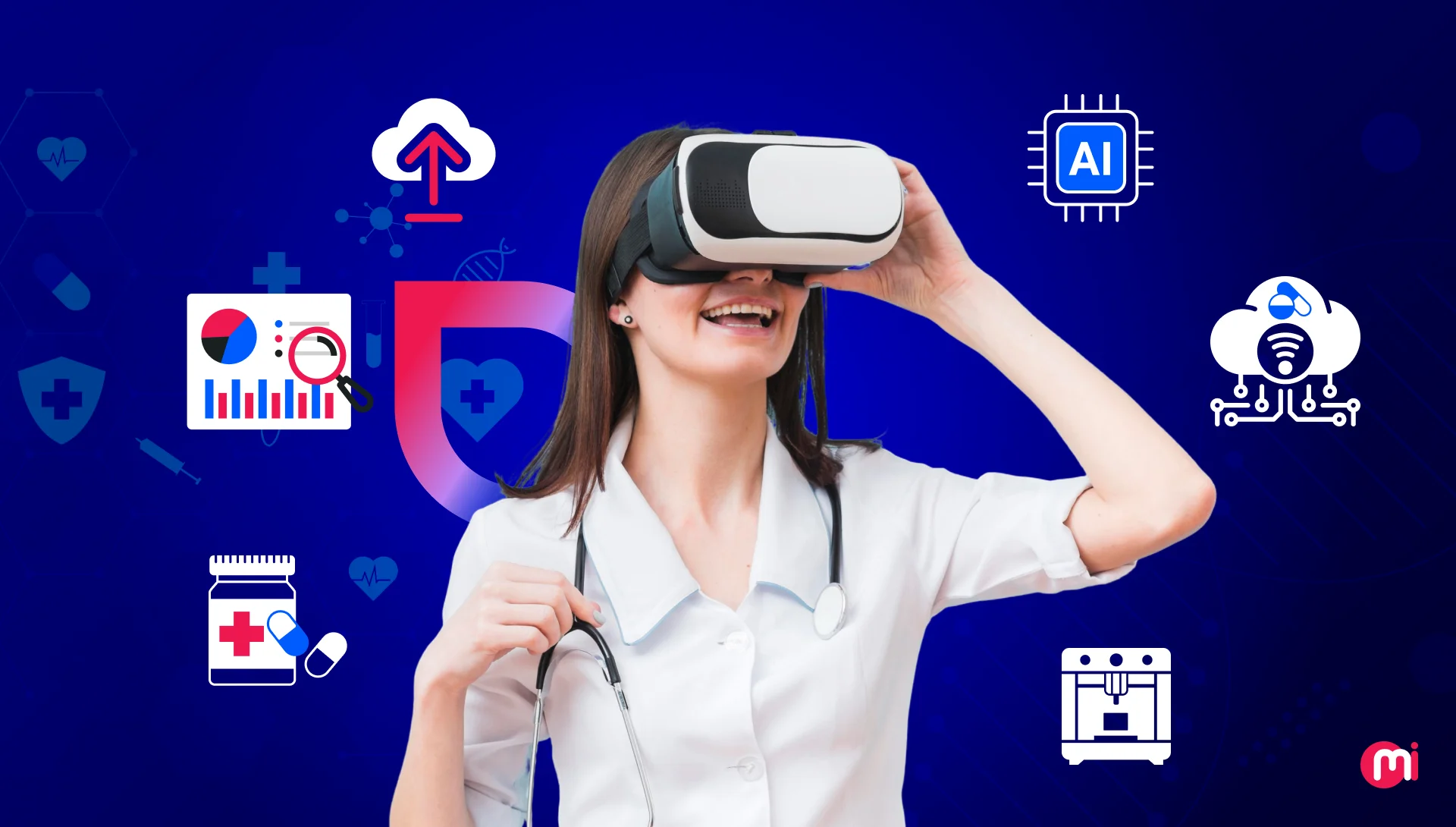Healthcare App Development Guide: Process, Features, Cost
- Business
- October 22, 2025
Healthcare mobile app development has become vital to modern medicine, understanding the development process, its core features, and associated costs is of utmost importance for anyone looking to innovate in this space. In this write-up, we will look at the clear roadmap on how to develop a healthcare app that is engaging, compliant, and effective.
Since the COVID-19, mobile health solutions have been empowering patients, streamlining medical workflows, and making healthcare more accessible than ever before. According to the recent studies done by Grand View Research, the global mHealth market size was estimated at USD 62.7 billion in 2023 and is expected to reach USD 158.3 billion by 2030, growing at a CAGR of 14.1% from 2024 to 2030.
The digits prove that mobile app development statistics in the global mHealth market are growing at a rapid rate. The number is driven by increasing adoption of smartphones and the growing demand for remote patient care. Moreover, from telehealth platforms to chronic disease management apps, the list of possibilities is endless today.
That said, creating a world-class healthcare app takes a lot more than having a great idea. It involves a deep understanding of user needs, adherence to regulatory standards like HIPAA, and a robust development process in place. Here in this write-up, we will cut through the complexities and provide you with a clear picture and step-by-step process for building a high-impact healthcare solution. Let’s get started.

Types of Healthcare Apps
Healthcare apps provide patients with easy access to medical information, medication reminders, symptom tracking, and telemedicine services, among other features. Let us now explore different types of healthcare apps.
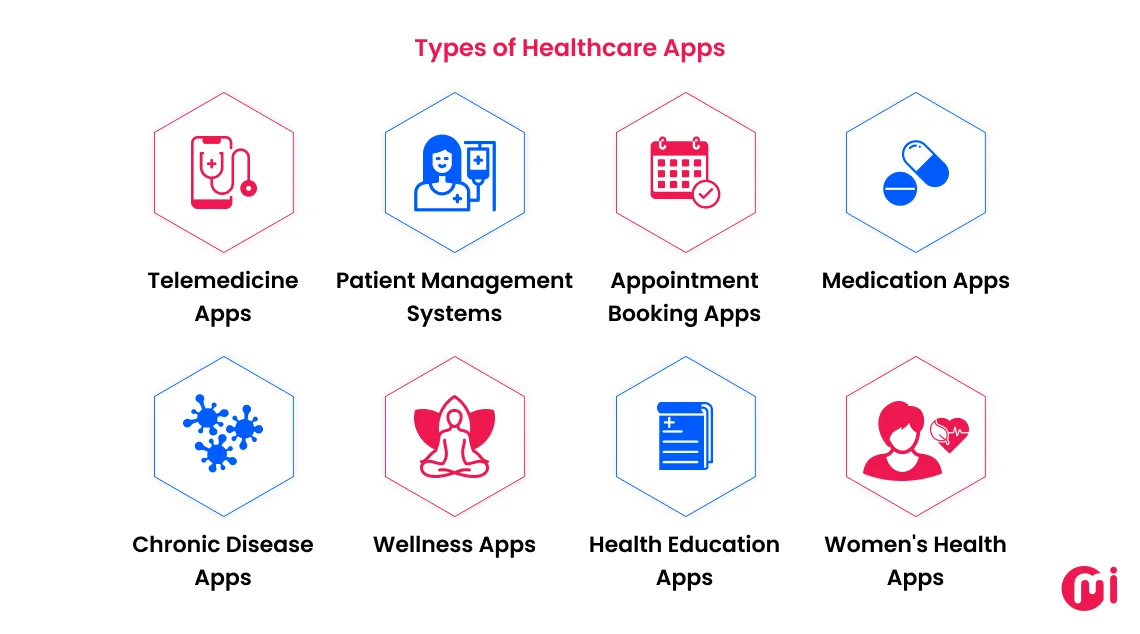
1. Telemedicine Apps
Telemedicine apps facilitate remote consultation between patients and healthcare providers. The features of this app include chat functionalities, video conferencing, and secure messaging, making it easy for patients to access healthcare services from the comfort of their homes.
2. Patient Management Systems
Patient management systems work in the best possible ways to manage patient data, track treatments, and streamline workflows. It allows for quick and secure access to vital information and data while ensuring the confidentiality of personal data.
3. Appointment Booking Apps
Appointment booking apps integrate scheduling for medical appointments. The app allows patients to book, reschedule, or cancel the visits 24/7. It is composed of two panels: a patient-facing panel and the management panel. The primary goal of this app is to simplify the procedure of scheduling hospital appointments.
4. Medication Apps
Medication apps, also known as e-prescribing apps, enable healthcare providers to manage their medications by providing authentic dosage information, reminders, and refill alerts. It eliminates the risk of missing and enhances adherence to prescribed regimens.
5. Chronic Disease Apps
These apps are targeted at patients with chronic conditions. They offer tools for tracking symptoms, communication, and medication adherence with healthcare providers. The app empowers users to take control of their state and provides timely intervention when issues arise.
6. Wellness Apps
The wellness app is focused on proactive health management. It promotes a healthy lifestyle through top-notch features like nutrition monitoring, fitness tracking, and personalized health insights. It integrates more features like mental health support, community engagement, and sleep tracking.
7. Health Education Apps
As the name suggests, these apps provide educational information on various health topics. Thus, empowering users with excellent knowledge about their conditions and wellness strategies. These applications help patients to make well-informed decisions related to their health.
8. Women’s Health Apps
Women’s health apps focus on women’s health issues specifically. It offers resources and tools customized to their unique needs. The features of these apps include: cycle tracking and pregnancy, personalized health tips, and top-notch community support.
Benefits of Healthcare App Development for Patients and Providers
One of the core reasons why healthcare apps have gained utmost popularity in the business sector is because of the countless benefits they provide to patients and healthcare providers. Let’s explore how.
Benefits for Medical Professionals
- Built-in Diagnostic Systems
These systems allow doctors to easily analyze and diagnose the condition of remote patients, track their progress, and determine treatments with the help of embedded IoT devices integrated with EHR platforms.
- Accurate Diagnosis
These apps help healthcare professionals with early and accurate diagnosis of the disease. With the best built-in diagnostic system comes a better treatment plan, timely healthcare delivery, and effective outcomes.
- Electronic Health Record
With the integration of the EHR solution, healthcare apps can easily track, store, and collect all the information related to a patient on a single platform. This helps in saving time, eliminates errors, and allows the sharing of patient data with different healthcare institutions.
- Telemedicine and Telehealth
Telemedicine and telehealth empower healthcare professionals to deliver remote services, facilitating online communication and providing top-notch medical care more efficiently. As a result, telehealth has become one of the most crucial components of modern healthcare delivery, offering patients access to care and helping providers to reach a broader patient base.
- E-Prescribing
It helps doctors to prescribe medications for patients with utmost accuracy. It eliminates the aspect of pharmacy errors. Thus, optimizes the time for both patient and doctor.
- Enhanced Communication
Healthcare applications help providers and doctors connect with patients remotely for discussions. With automated and streamlined workflows, healthcare providers pay more attention to patients and spend less time on administrative tasks.
- Better Service and Equipment Management
mHealth app developments allow users to easily monitor medical equipment in real-time and optimize its use accordingly. The benefit of real-time ensures that medical devices are always in great working condition, thus reducing downtime and enhancing overall patient care.
- Resource Optimization and Cost Reduction
Healthcare apps help medical providers cut down expenses by eliminating the paper cost, reducing staff overtime, and preventing extra medical errors that could lead to lawsuits. With everything running smoothly digitally, medical businesses need fewer people on board for administrative work.
- Improved Patient Compliance and Follow-up
By sending medical reminders about treatment plans and follow-ups, healthcare apps cut down the headache for doctors. When patients stick to their plans and reminders, doctors end up seeing fewer emergencies.
Benefits for Patients
- High-Quality Patient Care
With the help of advanced healthcare apps, patients have access to easily track their disease symptoms, chronic health conditions, and disrupted sleep patterns, and overall health with the help of IoT-connected wearable devices or smartphone sensors.
- Accessible Healthcare Data
A top-notch mobile app platform makes healthcare information and data easily accessible for better patient monitoring. Now, patients can easily access their healthcare information at home or on the go and share the data with their healthcare providers with ease.
- On-Demand Accessible Care
Mobile app development in healthcare has made medical services accessible to every common user. The healthcare app development services ensure the quick delivery of medical care services directly to the patient’s doorstep with real-time order tracking, automated prescription refills, and integration with telemedicine platforms.
- Better Communication
Medical healthcare apps provide patients with real-time connectivity, enabling seamless consultation and support. With features like video calls, instant messaging, and secure data sharing, patients can easily discuss their problems and receive guidance without any delays.
- Cost Saving and Financial Relief
With healthcare costs skyrocketing, these healthcare apps help patients in the best possible ways to reduce their expenses. For instance, instead of immediately rushing to the doctors for minor issues, patients can now reach them virtually, thus cutting down on physical visits.
- Health, Confidence, and Peace of Mind
One of the biggest benefits that most people do not discuss is the peace of mind and confidence that come with the help of rising healthcare app development trends, including the invention of mHealth apps. Users feel more confident using these apps because managing their health has now become easier.

The Healthcare App Development Process
Understanding how to develop a healthcare app is a meticulous journey. The process integrates various phases, each contributing to the overall cost and timeline. By analyzing each step, you can better plan your budget.
You can ensure that your mHealth app development delivers maximum value without overspending. Let’s now look at the breakdown of the healthcare app development process.
Step 1: Conduct Market Research
Before starting with the coding, the first step is to conduct market due diligence. This process involves analyzing the specific problems your app will solve, identifying your target audience, i.e., patients, healthcare, or both.
Ensure conducting a comprehensive market research to analyze the market gaps, identify your competitors, and validate your app idea. Furthermore, at this stage, it is also of utmost importance to understand the regulatory landscape of the region in relation to your project.
Step 2: Define Functionalities and Features
After validating your concept, the next step involves defining the core features of your Minimum Viable Product (MVP). Pay utmost attention to the features that deliver the most immediate value to your target users.
Before getting started, document your specific requirements clearly, such as will your app include: telemedicine capabilities, appointment scheduling, or EHR integration. This is one of the crucial steps of any app development for startups and it is a core principle for a top-notch enterprise application development services as well.
Step 3: Choose the Right Stack of Technology
Selecting the right stack plays a vital role that supports the specific needs of healthcare applications. By choosing the right set of programming languages, frameworks, and database technologies, you can ensure that the performance of the app is top-notch.
Furthermore, to simplify your third-party integration, such as payments, EHRs, and storage, you can opt for the stack that simplifies these processes for you. Thus enabling your app to adapt to brand new technologies and services over time.
Step 4: Design UI/UX
It goes without saying that healthcare apps must be accessible and intuitive to a diverse user base, including individuals who may not be tech-savvy. This is where creating a clean, simple, and engaging UI/UX falls into the picture.
With the help of a well-designed healthcare app, you can eliminate the learning curve for both patients and providers, thus leading to higher adoption rates. Moreover, crafting a clickable prototype at this stage is one of the best practices that allows you to gather early feedback and thus refine the user experience even before the development begins.
Step 5: Develop and Conduct QA
The development phase is where the app comes to life. The entire process is typically divided into sprints with front-end and back-end teams working in tandem. To have a successful healthcare mobile app development project, rigorous testing is non-negotiable.
It ensures the aspect of security vulnerability and data protection with the help of unit testing, integration testing, and user acceptance testing. The dedicated QA team conducts thorough checks to eliminate bugs and issues. Once the testing is done, the app can then be submitted to app stores for approval and launch.
Step 6: Deploy, Maintain, and Modernize the App
After passing all the stages and tests, the app is ready to be launched on different platforms. Yet again, the work does not end here. Post launch, you’ll have to stay ahead with monitoring app performance, gathering user feedback, and releasing regular updates to fix bugs and introduce new features.
With the advancements in technology, you might also need application modernization services to keep your app up-to-date and competitive.
Must-Have Features for Healthcare Apps
With the new development trends, the features of healthcare apps keep changing. When it comes down to mobile apps for the healthcare industry, the right set of features can significantly impact patient care and the entire efficiency of the system.
That said, you must be wondering what features to include in healthcare apps, right? Well, the key strategy is to pay attention to features that solve real problems for both doctors (healthcare providers) and patients. Let’s explore features that can elevate any healthcare app.
Features for Patient App
- Engaging UI/UX Design
One feature that makes the app easy to use and provides smooth navigation is user-friendly UI/UX. Ensure that the interface is basic and clear, with no complicated elements. Features like large buttons, plain layouts, and tutorials can improve the usability of the healthcare app.
- Telemedicine & Video Consultation
Another cornerstone of modern healthcare app development is the ability that it provides to conduct remote consultations. Integrating high-quality video calls with utmost security is crucial for any telemedicine app development project.
- Appointment Reminders & Scheduling
The feature of the intuitive calendar allows patients to book, reschedule, or cancel the appointment. The automated push notifications for reminders significantly eliminate no-shows.
- Prescription Management & Refills
Handling prescriptions becomes effortless with the help of appropriate app features. Clients can request medication refills or even arrange deliveries of the same through pharmacy integration.
Advanced features also integrate missed doses and alert caretakers. Furthermore, patients can scan the barcodes of the medications to identify the instructions, dosage, and drug names.
- Wearable Device Integration
These devices work in the best possible ways to accumulate patient information, such as heart rate, blood pressure. This helps healthcare providers understand the overall health of the patient.
- EHR/EMR Integration
The integration of EHR/EMR is vital for provider-facing healthcare applications. It allows doctors to access patients’ data directly within the app, thus streamlining the workflow. This integration ensures that both professionals and patients have access to up-to-date information.
- Symptom Checker
Symptom checker in the healthcare app offers a reliable and structured assessment of symptoms. After answering a few simple questions, patients know if they need to see a doctor or can take care of it on their own.
- 24/7 Chat Support
The feature of 24/7 support provides the users with instant access to healthcare professionals, thus saving time for a consultation. Now, the generative AI chatbots provide quick answers to common questions, making interactions with the providers even more efficient.
Features for Doctor’s App
- Clinical Decision Support Tools
This acts as one of the primary examples of the growing importance of AI in mobile app development, as it provides doctors with evidence-based recommendations that can help them make appropriate decisions. These features are linked to patient data, providing suitable recommendations for medications, diagnosis, and treatments.
- Workflow and Task Management
The feature of workflow and task management integrated into the application helps doctors to organize their time, track their to-do list, and prioritize urgent tasks. It works in the best possible ways to help doctors organize their day-to-day work and also enhances team collaboration.
- Integrated Billing and Payments
Payments and billings are often time-consuming to manage. This feature allows healthcare professionals to access the billing record, generate invoices, and receive payments right within the app, thus reducing the administrative burden.
- Patient Dashboard
The patient dashboard acts as a game-changer tool for doctors. It presents them with a quick and clear view of the patient’s health status. By providing an overview of patients’ health data, medication, and treatment history, it helps healthcare providers to easily make fast and better decisions.

How to Estimate Healthcare App Development Costs?
Estimating and analyzing the cost to develop a medical healthcare app broadly depends on two factors. These are:
- The total development hours required
- The hourly rates of the development team
Well, here is a simple trick or a formula that can help you get an estimate of healthcare app development cost:
Development Hours × Developers’ Hourly Rate = Total Cost
By understanding this formula and keeping insight into the factors that can impact the cost of developing an mHealth app, you can get an accurate cost projection of your healthcare app. Now you must be wondering what the factors are that can impact the cost, right? Let’s explore them.
Factors that Impact the Cost of Developing an mHealth App
- Mobile App Complexity
The complexity of an app directly impacts the development time and cost. It goes without saying that a simple app with basic features will be less expensive than a complex one.
- App Features and Functionalities
The intricacy of features added in a healthcare app is one of the major cost drivers. An app with many features and customizations requires more development time and resources.
- Trends and Technologies
Implementing the latest technologies like AI, ML, and real-time tracking adds to the app’s complexity and overall cost. It requires specialized expertise and longer development cycles.
- UI/UX
A complex UI/UX will result in increased development costs. While a high-quality design is crucial for user engagement, it demands more time and special skills from developers.
- App Platform Selection
Developing an app on multiple platforms requires additional development and testing efforts, which in turn results in increased app development costs.
- Technology Stack
The choice of programming languages and frameworks significantly impacts the final cost. Furthermore, this cost can be further influenced by licensing fees and availability, and the hourly rate of the developer.
- Backend Complexity
The complexity of the backend architecture is a crucial cost factor. A simple app is way more cost-efficient to develop than a client-server app that requires a complex backend for real-time data syncing, security, and user management.
- Hosting & Server Costs
The total cost of an app also includes ongoing expenses for the server hosting and maintenance. The choice of hosting provider influences the initial setup and recurring operational costs.
- Third-Party Integration
Integrating a healthcare app with external systems such as third-party APIs, EHRs, and payment gateways adds to the development complexity and cost.
- Size of Development Team
The size of the development team impacts the budget directly. A more complex project requires a larger team of developers, designers, project managers, and QA engineers, leading to higher costs.
- Location of Development Team
The cost of the developer varies significantly depending on the geographical location, making it one of the major factors in overall development cost.
Conclusion
Healthcare mobile app development offers a revolutionary opportunity to enhance patient care, improve providers’ efficiency, and make healthcare accessible to everyone. However, building a successful and competitive app requires more than just technical skills such as leveraging comprehensive mobile application development services for healthcare that cater to your diverse requirements.
Furthermore, it requires an in-depth understanding of the healthcare industry. The journey from idea to market-ready product involves careful research and planning, strategic feature prioritization, and a strong development partner. This is where MindInventory can help you. Our team of experts specializes in providing end-to-end healthcare solutions, helping you from the initial start to developing a top-notch healthcare app and beyond.
FAQs
Important features that can be added in healthcare app development are:
– Appointment scheduling
– User authentication
– Prescription management
– Telemedicine integration
– Symptom checkers
– Real-time chat support
– Payment integration
The cost of developing a top-notch healthcare app depends on different factors, such as the complexity of the app, features and functionalities, trends and technologies, UI/UX design, app platform selection, backend complexity, hosting and server costs, third-party integration, and the size of the development team. The cost varies depending on how one customizes the app.
When choosing an app development company for a healthcare app, ensure to look for a company with a proven track record in healthcare app development, with expertise in compliance, a strong portfolio in relevant projects, and a deep understanding of trending technologies like AI, ML, and IoT.
When it comes to estimating the ROI, understand that it includes both costs and benefits. The formula to calculate your ROI is:
ROI (%) = ((Total benefits – Total costs) ÷ Total costs) × 100
